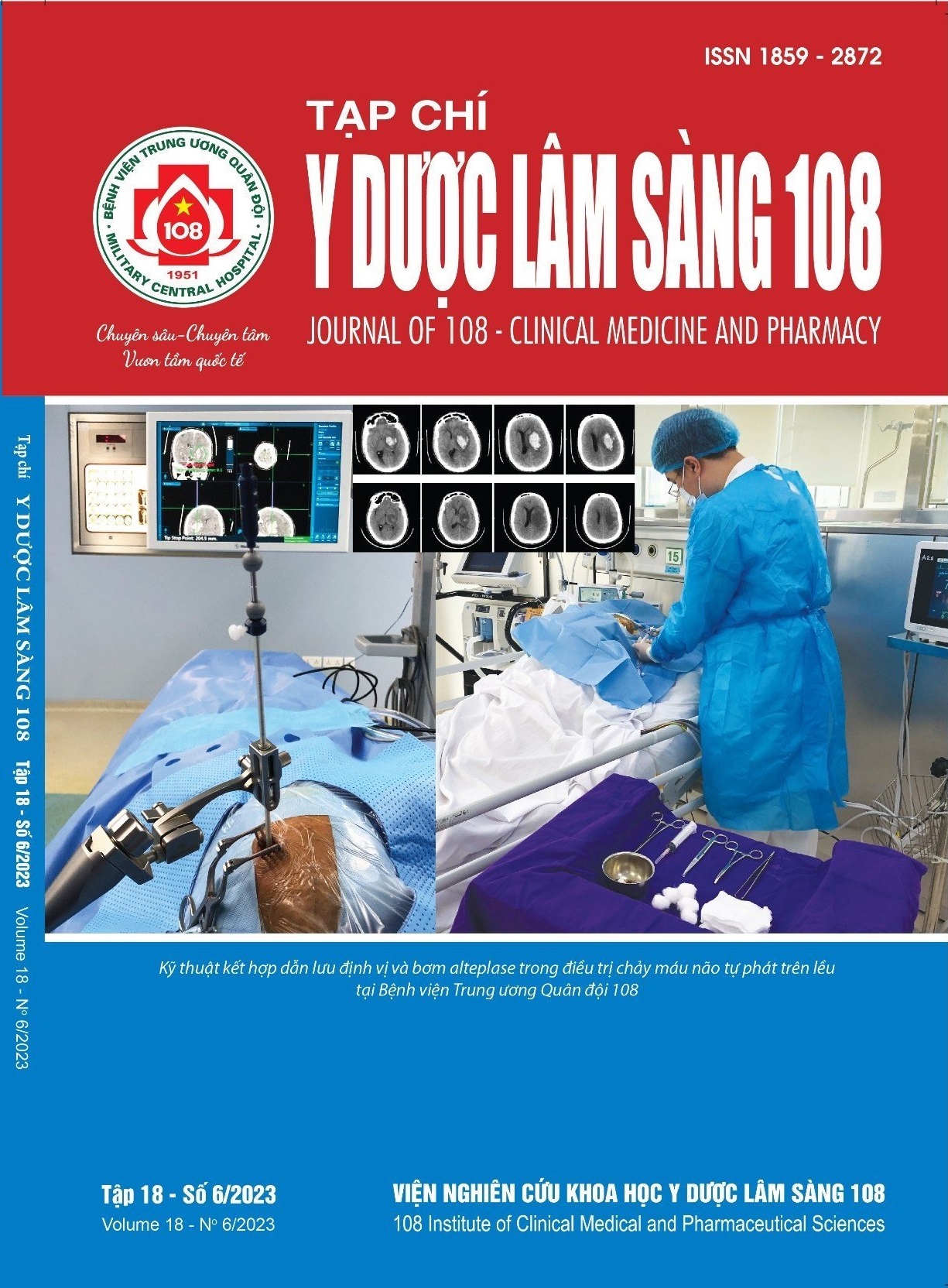Nghiên cứu mối liên quan giữa trầm cảm và hình ảnh tổn thương não trên cắt lớp vi tính ở bệnh nhân nhồi máu não
Main Article Content
Keywords
Nhồi máu não, trầm cảm, trầm cảm sau đột quỵ, cắt lớp vi tính sọ não
Tóm tắt
Mục tiêu: Tìm hiểu mối liên quan giữa trầm cảm và hình ảnh tổn thương não trên cắt lớp vi tính ở bệnh nhân nhồi máu não. Đối tượng và phương pháp: Nghiên cứu tiến cứu, mô tả cắt ngang, 141 bệnh nhân nhồi máu não tại Khoa Đột quỵ, Bệnh viện Quân y 103. Kết quả: Tỉ lệ trầm cảm do nhồi máu não thuỳ trán 66,7% so với không tổn thương thuỳ trán (30,2%), khác biệt có ý nghĩa thống kê so với p<0,05. Đường kính trung bình của ổ nhồi máu não có trầm cảm là 28,94 ± 27,64mm, cao hơn so với nhóm không trầm cảm là 17,27 ± 16,25mm, khác biệt có ý nghĩa thống kê với p<0,05. Kết luận: Nhồi máu não thuỳ trán, đường kính ổ nhồi máu có liên quan đến trầm cảm sau đột quỵ.
Article Details
Các tài liệu tham khảo
1. Towfighi A, Ovbiagele B, El Husseini N, Hackett ML, Jorge RE, Kissela BM, Mitchell PH, Skolarus LE, Whooley MA, Williams LS; American Heart Association Stroke Council; Council on Cardiovascular and Stroke Nursing; and Council on Quality of Care and Outcomes Research (2017) Poststroke depression: A scientific statement for healthcare professionals from the American Heart Association/American Stroke Association. Stroke 48(2): 30-43.
2. Williams LS, Brizendine EJ, Plue L, Bakas T, Tu W, Hendrie H, Kroenke K (2005) Performance of the PHQ-9 as a screening tool for depression after stroke. Stroke 36(3): 635-638.
3. Spalletta G, Guida G, De Angelis D, Caltagirone C (2002) Predictors of cognitive level and depression severity are different in patients with left and right hemispheric stroke within the first year of illness. J Neurol 249(11): 1541-1551.
4. Starkstein SE, Robinson RG, and Price TR (1987) Comparison of cortical and subcortical lesions in the production of poststroke mood disorders. Brain 110(4): 1045-1059.
5. Narushima K, Kosier J, and Robinson RG (2003) A reappraisal of poststroke depression, intra-and inter-hemispheric lesion location using meta-analysis. The Journal of neuropsychiatry and clinical neurosciences 15(4): 422-430.
6. Robinson RG and Jorge RE (2016) Post-stroke depression: A review. American Journal of Psychiatry 173(3): 221-231.
7. Zhang T, Jing X, Zhao X, Wang C, Liu Z, Zhou Y, Wang Y, Wang Y (2012) A prospective cohort study of lesion location and its relation to post-stroke depression among Chinese patients. Journal of Affective Disorders 136(1-2): 83-87
2. Williams LS, Brizendine EJ, Plue L, Bakas T, Tu W, Hendrie H, Kroenke K (2005) Performance of the PHQ-9 as a screening tool for depression after stroke. Stroke 36(3): 635-638.
3. Spalletta G, Guida G, De Angelis D, Caltagirone C (2002) Predictors of cognitive level and depression severity are different in patients with left and right hemispheric stroke within the first year of illness. J Neurol 249(11): 1541-1551.
4. Starkstein SE, Robinson RG, and Price TR (1987) Comparison of cortical and subcortical lesions in the production of poststroke mood disorders. Brain 110(4): 1045-1059.
5. Narushima K, Kosier J, and Robinson RG (2003) A reappraisal of poststroke depression, intra-and inter-hemispheric lesion location using meta-analysis. The Journal of neuropsychiatry and clinical neurosciences 15(4): 422-430.
6. Robinson RG and Jorge RE (2016) Post-stroke depression: A review. American Journal of Psychiatry 173(3): 221-231.
7. Zhang T, Jing X, Zhao X, Wang C, Liu Z, Zhou Y, Wang Y, Wang Y (2012) A prospective cohort study of lesion location and its relation to post-stroke depression among Chinese patients. Journal of Affective Disorders 136(1-2): 83-87
 ISSN: 1859 - 2872
ISSN: 1859 - 2872
